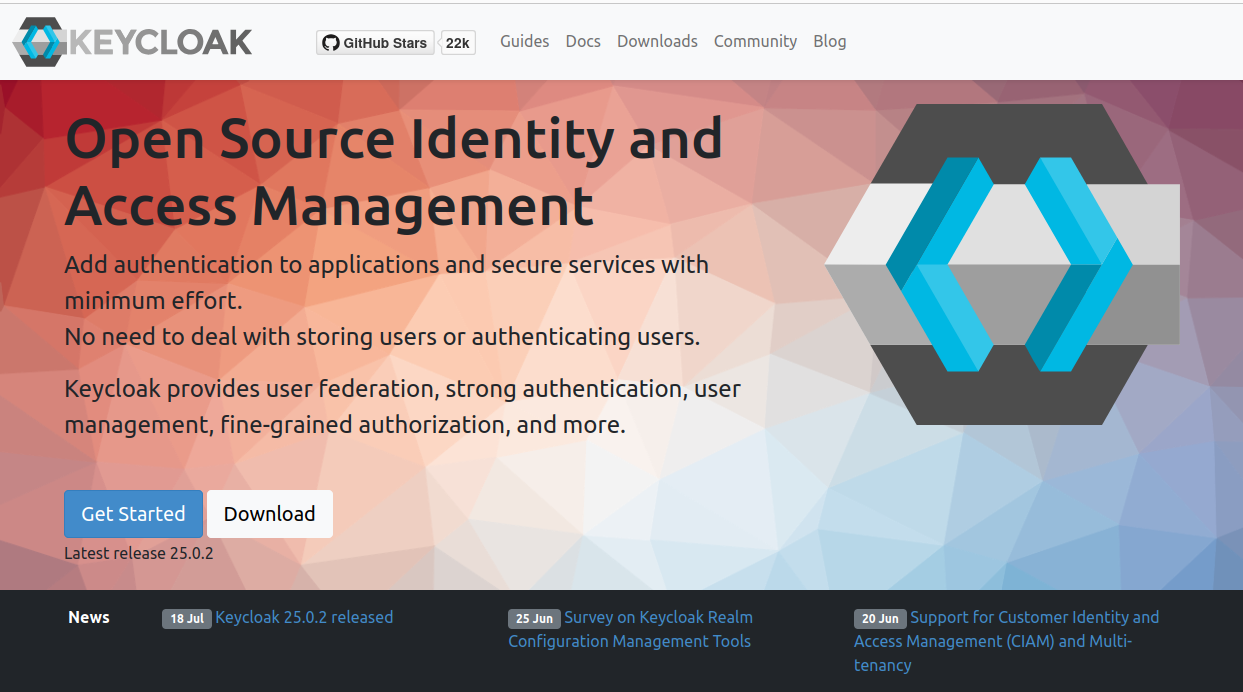Keycloak Identity and Access Management
Keycloak is a very powerful and well established solution for providing IAM solutions for all kind of services.
Preparation
Requirements are:
Installation
As a postgres admin we create a keycloak user and role and the keycloak database
cd ~/homekube/src/keycloak
envsubst < create-keycloak.sql | kubectl exec postgres-0 -i -n postgres -- psql -U admin -d postgres
You should be able to log into the keycloak database as the keycloak user and list the content:
root@homekube:~/homekube/src/keycloak# kubectl exec postgres-0 -it -n postgres -- psql -U keycloak -d keycloak
psql (16.3 (Debian 16.3-1.pgdg120+1))
Type "help" for help.
keycloak=> \l
List of databases
Name | Owner | Encoding | Locale Provider | Collate | Ctype | ICU Locale | ICU Rules | Access privileges
-----------+-------+----------+-----------------+------------+------------+------------+-----------+-------------------------
homekube | admin | UTF8 | libc | en_US.utf8 | en_US.utf8 | | |
keycloak | admin | UTF8 | libc | en_US.utf8 | en_US.utf8 | | | =Tc/admin +
| | | | | | | | admin=CTc/admin +
| | | | | | | | keycloak_role=CTc/admin
postgres | admin | UTF8 | libc | en_US.utf8 | en_US.utf8 | | |
template0 | admin | UTF8 | libc | en_US.utf8 | en_US.utf8 | | | =c/admin +
| | | | | | | | admin=CTc/admin
template1 | admin | UTF8 | libc | en_US.utf8 | en_US.utf8 | | | =c/admin +
| | | | | | | | admin=CTc/admin
(5 rows)
keycloak=> \q
root@homekube:~/homekube/src/keycloak#
Now lets complete the installation. During initial setup all keycloak tables will be created automatically.
Lets execute the installation script.
Reminder to (modify and) set environment variables first !
set -a
. ../homekube.env.sh # set your env vars with the -a option
root@homekube:~/homekube/src/keycloak# . ./install.sh
Initial setup takes a while. Be patient. On successful installation your keycloak namespace should look like:
root@homekube:~/homekube/src/keycloak# kubectl get all -n keycloak
NAME READY STATUS RESTARTS AGE
pod/keycloak-74dd784dd9-xjld2 1/1 Running 0 17h
NAME TYPE CLUSTER-IP EXTERNAL-IP PORT(S) AGE
service/keycloak ClusterIP 10.152.183.153 <none> 8080/TCP 2d1h
NAME READY UP-TO-DATE AVAILABLE AGE
deployment.apps/keycloak 1/1 1 1 2d1h
NAME DESIRED CURRENT READY AGE
replicaset.apps/keycloak-74dd784dd9 1 1 1 2d1h
Check that keycloaks tables have been created
psql (16.3 (Debian 16.3-1.pgdg120+1))
Type "help" for help.
keycloak=> \dl
Large objects
ID | Owner | Description
List of relations
Schema | Name | Type | Owner
--------+-------------------------------+-------+----------
public | admin_event_entity | table | keycloak
public | associated_policy | table | keycloak
public | authentication_execution | table | keycloak
public | authentication_flow | table | keycloak
public | authenticator_config | table | keycloak
public | authenticator_config_entry | table | keycloak
public | broker_link | table | keycloak
...
\q
Now lets check if we are able to open the keycloak admin ui. It should be available as specified in the keycloak ingress definition keycloak.${HOMEKUBE_DOMAIN} e.g. https://keycloak.auth.homekube.org
Username: admin
Password: ${HOMEKUBE_KEYCLOAK_PASSWORD}
Now you can proceed with the configuration.
Inspection and Deinstallation
If you are curious then have a deeper look into your database. Here is a list of commands of the psql command line tool Be careful. Its easy to riun the installation.
kubectl exec postgres-0 -it -n postgres -- psql -U admin -d postgres
Drop DB and users
envsubst < drop-keycloak.sql | kubectl exec postgres-0 -i -n postgres -- psql -U admin -d postgres
Backup and restore
Use a helper psql client:
kubectl run -it postgres-client --image=postgres:16 --restart=Never -- bash
Backup
pg_dump -f /tmp/keycloak.backup --host <from-host-ip> --port "30100" --username "keycloak" --format=c -v keycloak
Restore
psql -U admin -d postgres -c "drop database keycloak;"
psql -U admin -d postgres -c "create database keycloak;"
pg_restore -d keycloak /tmp/keycloak.backup --host <to-host-ip> --port "30100" --username "admin" --format=c
Backup from inside postgres container
# step into postgres container
kubectl exec postgres-0 -it -n postgres -- bash
# dump the database to /tmp/keycloak.backup in postgres container
pg_dump -f /tmp/keycloak.backup --username "keycloak" --format=c -v keycloak
# copy to parent (e.g. /root/keycloak.backup)
kubectl cp postgres/postgres-0:tmp/keycloak.backup keycloak.backup
# pull file to lxc host
lxc file pull homekube/root/keycloak.backup .
Restore from host
# push file from host to lxc container homekube
lxc file push keycloak.backup homekube/root/keycloak.backup
# copy from parent (homekube) to postgres container
kubectl cp keycloak.backup postgres/postgres-0:tmp/keycloak.backup
# step into postgres container
kubectl exec postgres-0 -it -n postgres -- bash
# start with a clean keycloak db before restoring a backup
psql -U admin -d postgres -c "drop database keycloak;"
psql -U admin -d postgres -c "create database keycloak;"
# restore the database from /tmp/keycloak.backup
pg_restore -d keycloak /tmp/keycloak.backup --username "admin" --format=c


